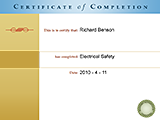Bloodborne Pathogens: Always Protect Yourself (HD)
- Product ID
- clmibpap
- Training Time ?
- 44 to 88 minutes
- Language(s)
- English,Spanish
- Video Format
- High Definition
- Required Plugins
- MasteryNet Player
- Lesson Interactions
- 14
- Quiz Questions
- 26
- Closed Captioning



This training teaches workers to protect themselves from bloodborne pathogens. Learners view an exposure incident and then experiences the perspective from three individuals: the victim, the responder, and the co-worker. In each case, employees view ways to protect themselves any time they are potentially exposed to an incident involving blood or other body fluids.
This course defines bloodborne pathogens, explains how they are transmitted, and details methods of using universal precautions. Workers learn that staying safe includes the use of Personal Protective Equipment (PPE), safe work practices, proper clean up and disposal, and follow-up in the case of exposure.
![]() This course is in the Advantage™ format, to read about Advantage™ features click here.
This course is in the Advantage™ format, to read about Advantage™ features click here.

- Install on any SCORM LMS
- Rich multimedia presentation with interactions and quiz
- Print certificate and wallet card
- You have 30 days to complete the course
All workers.
-
Defining Bloodborne Pathogens
- Defining Bloodborne Pathogens
- HIV vs. Hepatitis B
- Hepatitis C and beyond
-
Transmitting Bloodborne Pathogens
- How you get infected
- The three ways of transmission
- Defining contamination
-
Universal Precautions
- The three main elements of protection
- Defining universal precautions
- Questions to ask yourself
-
Personal Protective Equipment (PPE)
- Typical protective equipment
- CPR protective equipment
- Where you need to protect yourself
-
Safe Work Practices
- Defining safe work practices
- Removing gloves
- Washing hands
- Removing body fluids from non-intact skin
- Washing contaminated clothing
-
Clean Up and Disposal
- Using the proper personal protective equipment
- Using a disinfectant
- Cleaning sharp objects
- Waste disposal
-
Exposure Follow-up
- Immediate evaluation
- Follow-up and evaluation procedures
- Blood testing
-
Bloodborne Pathogens Standard
- The OSHA Standard requirements
- Protecting yourself
-
Recognize bloodborne pathogens.
- Define Bloodborne Pathogens.
- Agree that not all body fluids are infectious.
- State that Hepatitis B virus is 50 to 100 times more infectious than HIV.
- Choose Hepatitis B as the only common bloodborne pathogen with an available vaccine.
- List conditions caused by exposure to Hepatitis C.
-
Avoid the transmission of Bloodborne Pathogens.
- Agree that getting someone's blood or body fluids on your skin will not infect you.
- List ways Bloodborne Pathogens can be transmitted into your body.
- Define contaminated.
-
Always use universal precautions.
- List the three main elements of protection.
- Define Universal Precautions.
- Explain how to determine if body fluids are hazardous.
-
Wear proper personal protective equipment to avoid bloodborne hazards.
- List forms of PPE used to protect yourself from bloodborne hazards.
- Identify the proper PPE to use when performing CPR.
- Agree to protect yourself before helping an injured person.
-
Follow safe work practices to prevent exposure to Bloodborne Pathogens.
- Select the proper procedures to remove gloves.
- List steps to properly wash hands.
- Identify proper procedure to follow if blood or body fluids get on non-intact skin.
- Choose proper procedures to follow for contaminated street clothes.
-
Properly clean and dispose of blood and body fluids.
- Choose the first step to safely cleaning blood.
- Recall the formula for cleaning with bleach and water.
- Select the proper way to clean contaminated, broken glass.
- Choose the proper place for all regulated waste.
-
Complete follow-up procedures in the event of an exposure.
- Identify the need to get an evaluation immediately following an exposure.
- List items included in follow-up and evaluation.
- Agree that a person whose blood or other potentially infectious material is exposed to someone has the right to refuse a blood test.
© Mastery Technologies, Inc.




